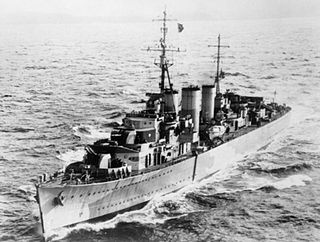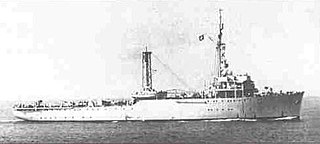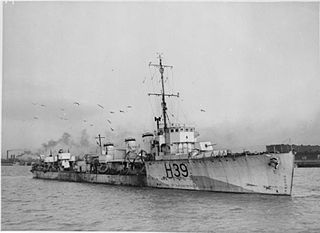
HMS Kelvin was a K-class destroyer of the Royal Navy laid down by the Fairfield Shipbuilding and Engineering Company, Limited, at Govan in Scotland on 5 October 1937, launched on 19 January 1939 and commissioned on 27 November 1939 with the pennant number F37.

The fourth USS Preble (DD-345/DM-20/AG-99) was a United States Navy Clemson-class destroyerin commission from 1920 to 1945. She served in China, including on the Yangtze Patrol, and later saw combat in World War II as a minelayer. She was named for Commodore Edward Preble.

HMS Black Prince was a Dido-class light cruiser of the Royal Navy, of the Bellona subgroup. The cruiser was commissioned in 1943, and served during World War II on the Arctic convoys, during the Normandy landings, and as part of the British Pacific Fleet. In 1946, the cruiser was loaned to the Royal New Zealand Navy, becoming HMNZS Black Prince. The cruiser was docked for modernisation in 1947, but in April, her sailors walked off the ship as part of a series of mutinies in the RNZN. The shortage of manpower resulting from these mutinies meant that the modernisation had to be cancelled, and Black Prince was placed in reserve until 1953. She returned to service after refitting with simplified secondary armament with a single quad "pom pom" in Q position and eight Mk3 40mm Bofors guns. The ship was decommissioned again two years later, and returned to the Royal Navy in 1961. Black Prince did not re-enter service, and was towed from Auckland to Osaka for scrapping in 1962.

The Abdiel class were a class of six fast minelayers commissioned into the Royal Navy and active during the Second World War. They were also known as the Manxman class and as "mine-laying cruisers". These ships were armed with a wide variety of defensive weapons from 0.5-inch (13 mm) machine guns to the 4-inch (100 mm) main armament. They were also equipped with a wide array of radars, along with their normal complement of mines. They were easily mistaken for destroyers. Half the class was lost through enemy action during the Second World War; the others saw post-war service, and the last example was scrapped in the early 1970s.

HMS Abdiel was an Abdiel-class minelayer that served with the Royal Navy during World War II. She served with the Mediterranean Fleet (1941), Eastern Fleet (1942), Home Fleet (1942–43), and the Mediterranean Fleet (1943). Abdiel was sunk by German mines in Italy's Taranto harbour in 1943. Although designed as a fast minelayer her speed and capacity made her suitable for employment as a fast transport.

HMS Adventure, pennant number M23, was an Adventure-class minelaying cruiser of the Royal Navy built in the 1920s that saw service during the Second World War. Her commander between 1928 and 1929 was the future First Sea Lord John H. D. Cunningham. Laid down at Devonport in November 1922 and launched in June 1924, Adventure was the first vessel built for service as a minelayer; she was also the first warship to use diesel engines, which were used for cruising. Adventure first joined the Atlantic Fleet, then was transferred to the China Station in 1935. In World War II, the ship was damaged in 1941 and 1944, and was converted to a landing craft repair in 1944. In 1945 Adventure was reduced to reserve and in 1947 she was sold and broken up for scrap.
Eight ships of the Royal Navy have borne the name HMS Ariadne, after the Greek goddess:

HMS Wakeful was a W-class destroyer of the Royal Navy launched in 1943. She saw service during the Second World War and was later converted into a Type 15 fast anti-submarine frigate. She was sold for scrap in 1971.

The Shoreham-class sloops were a class of eight warships of the Royal Navy built in the early 1930s.

HNLMS Zwaardvisch (S814) was the lead ship of the Royal Netherlands Navy's Zwaardvisch-class submarine, which was based on the British T class. The submarine was originally ordered as HMS Talent (P322) and built by Vickers Armstrong, Barrow. It served mainly in the Pacific against the Japanese during the war, operating under both British and US operational command in Ceylon and Australia. In 1950, the vessel was renamed HNLMS Zwaardvis. She was sold and broken up for scrap in 1963.

HMS Welshman was an Abdiel-class minelayer of the Royal Navy, launched in September 1941. During World War II she served with the Home Fleet carrying out minelaying operations, before being transferred to the Mediterranean Fleet in mid-1942 for the Malta Convoys. She also saw service during Operation Torch. The ship was torpedoed and sunk off Tobruk by the German submarine U-617 on 1 February 1943, with the loss of 157 lives.

HMS Manxman (M70) was an Abdiel-class minelayer of the Royal Navy. The ship is named for an inhabitant of the Isle of Man. It served in the Mediterranean during World War II, and entered the Reserve Fleet following the end of the war.

HMS Apollo was an Abdiel-class minelayer of the Royal Navy, the eighth RN ship to carry the name. She served with the Home Fleet during World War II, taking part in the Normandy Landings before being transferred to the British Pacific Fleet. Put into reserve in 1946, she was recommissioned in 1951, serving until 1961, and was sold for scrapping in 1962.
HMS Abdiel was a Royal Navy minelayer that saw service during the Cold War.

The Yugoslav minelayer Zmaj was built in Weimar Germany for the Royal Yugoslav Navy in the late 1920s. She was built as a seaplane tender, but does not appear to have been much used in that role and was converted to a minelayer in 1937. Shortly before the Axis invasion of Yugoslavia in April 1941 during the Second World War, she laid minefields along the Dalmatian coast, perhaps inadvertently leading to the sinking of two Yugoslav passenger ships. Slightly damaged by Italian dive bombers and then captured by the Italians during the invasion, she was soon handed over to the Germans. While in their service the ship was renamed Drache, had her anti-aircraft (AA) armament improved, and was used as a seaplane tender and later as a troop transport. In the latter role she participated in over a dozen convoys between the Greek port of Piraeus and the Greek island of Crete between December 1941 and March 1942.

HMS Venturous (D87) was a V-class destroyer of the British Royal Navy that saw service in World War I.

HMS Abdiel was a Marksman-class flotilla leader of the Royal Navy, built by Cammell Laird during the First World War. She was converted to a minelayer during construction, commissioning during 1916, and served at the Battle of Jutland. Following the end of the war, Abdiel served in the Baltic during the Russian Civil War. She was sold for scrap in 1936.

HMS Tarpon was a Royal Navy R-class destroyer constructed and operational in the First World War. She is named after the large fish Tarpon; one species of which is native to the Atlantic, and the other to the Indo-Pacific Oceans. Tarpon was built by the shipbuilders John Brown & Company at their Clydebank shipyard and was launched in March 1917 and entered service in April that year.

HMS Princess Margaret was a minelayer operated by the British Royal Navy during and after the First World War. She was built by the Scottish shipbuilder William Denny for the Canadian Pacific Railway as a liner to serve on the Pacific West Coast, and as such was powered by geared steam turbines, giving a speed of 23 knots.
HMS Gabriel was a Marksman-class flotilla leader of the British Royal Navy, that took part in the First World War. The ship was built by Cammell Laird at Birkenhead, being launched on 23 December 1915 and entering service in July 1916. Gabriel served with the Grand Fleet, leading a destroyer flotilla and was later used as a minelayer. She survived the war, before being sold for scrap on in May 1921.
















